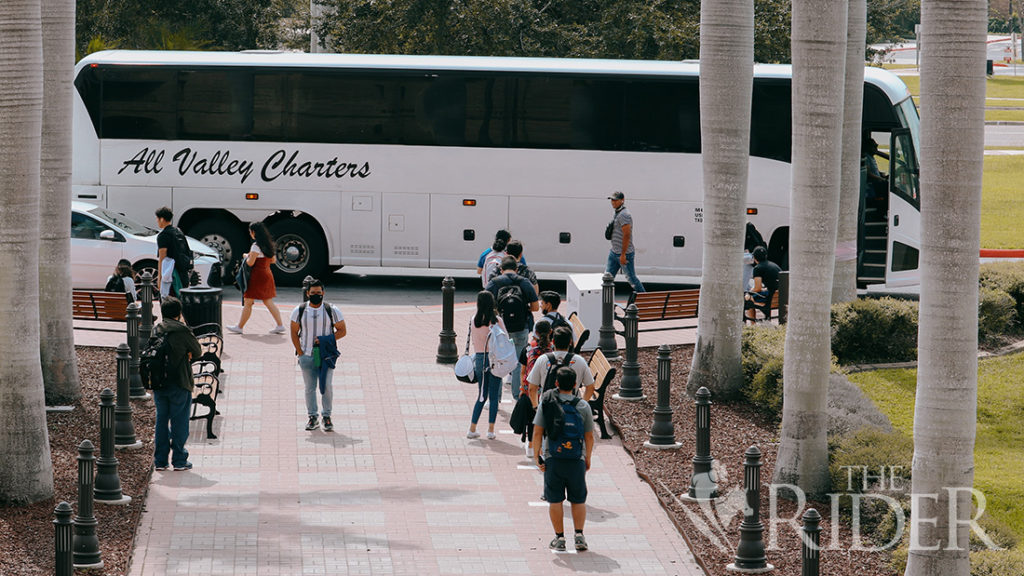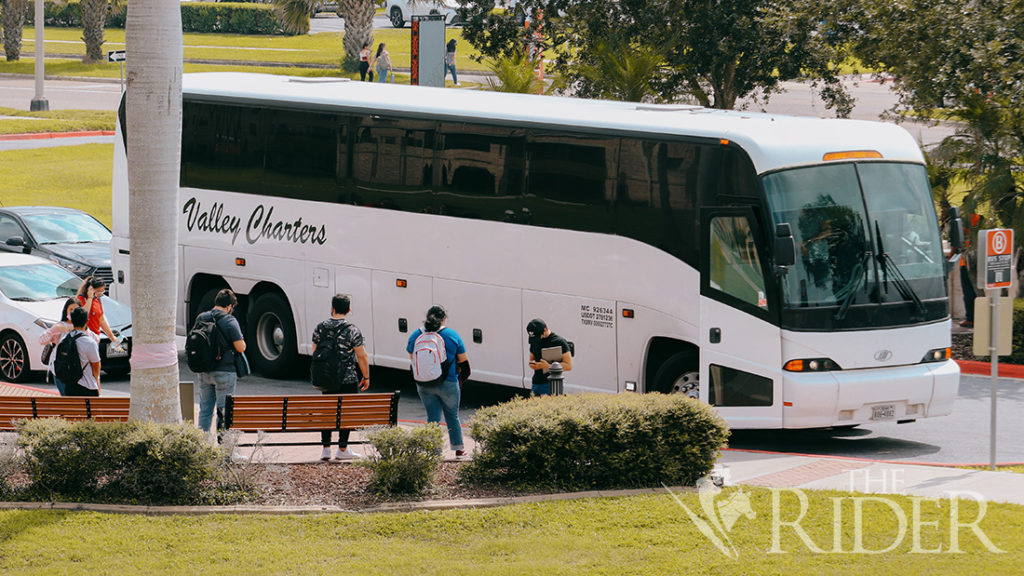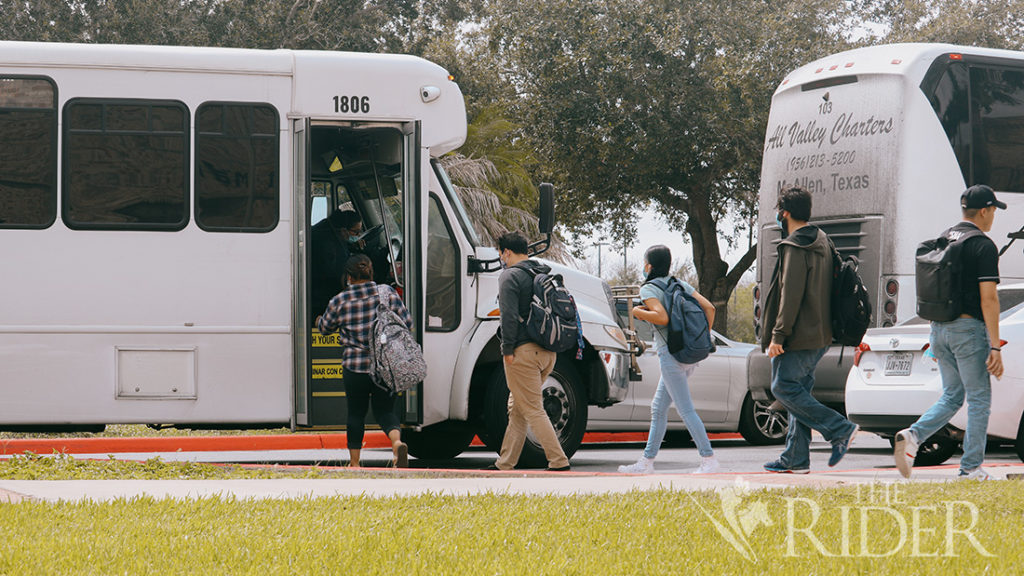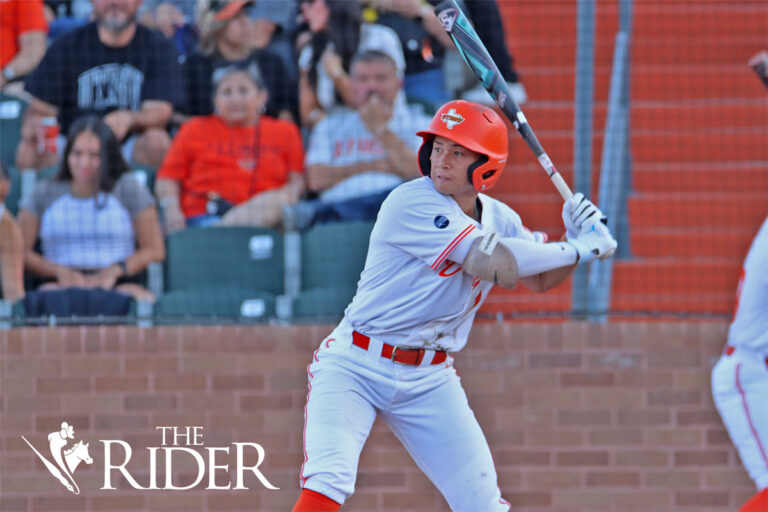
Students wait to board the shuttle on the Brownsville campus last Wednesday. A decrease of passengers was seen on the second week of school due to classes changing their modality from traditional to online. Ridership numbers average about 600 passengers each day on Mondays and Wednesdays and reach 800 passengers on Tuesdays and Thursdays. Luis Martinez Santillano/The Rider Photos
Shuttle ridership numbers experienced a drop from the beginning of the Fall 2021 semester to now, said Ian Chavez, UTRGV’s assistant director of transportation.
“I believe about the second week of when the fall semester started, several classes were changing their modality from traditional to online,” Chavez said in an interview last Monday. “So, the actual ridership has gone down.”
In an email sent to The Rider last Tuesday, he said during the first week of the semester, the passenger totals were 1,007 Monday; 1,055 Tuesday; 975 Wednesday and 971 Thursday.
New ridership numbers average about 600 passengers Mondays and Wednesdays and close to 800 passengers Tuesdays and Thursdays, according to Chavez.
Despite the decrease, no changes have been made to the shuttle service.
The Vaquero Express fleet consists of:
–five 42-passenger buses
–five 22-passenger buses
–two 30-passenger buses
–a 20-passenger bus
–a 14-passenger bus
–two 15-passenger vans.

Luis Martinez Santillano/The Rider Photo
UTRGV has also outsourced two 55-passenger buses to assist the Vaquero Express fleet.
The service runs from 6 a.m. to 11 p.m. Monday through Thursday, and from 6 a.m. to 8 p.m. Fridays.
The busiest times for each campus are 7:30 a.m. to 12:30 p.m. in Brownsville and 12:30 p.m. to 5 p.m. in Edinburg, according to Chavez.
“Basically, we use the class course schedule to see when the classes end and kind of use that to gauge our departure times,” he said. “We want to make sure that no passenger is left behind. Even if there’s a late class and there’s two passengers only using it, we’ll meet that demand for that service.”
Rick Flores, a biology junior primarily on the Brownsville campus, takes the shuttle to Harlingen almost every day.
Flores said that there are not a lot of students taking the shuttle from Brownsville to Harlingen.
“Usually they’re not too long,” he replied when asked about the lines. “But, like, for the … Edinburg shuttle, that one usually stretches [back behind the benches in front of Main].”
Andres Ingram is a manufacturing and industrial engineering sophomore who regularly rides the shuttle to attend his classes in Edinburg.
“I use it pretty much every day because all my manufacturing classes are in Edinburg,” Ingram said.
He said he noticed a decrease in passengers, but that some times are busier than others.
“Sometimes, it really depends on the hour,” he said. “I would really like to have a big [physical] timetable, you know, because the only timetable we have is on the website.”
UTRGV has plans for canopies to keep riders out of the elements while they wait for the shuttle.
Gerardo Rodriguez, UTRGV’s director of Facilities, Planning and Construction, said the canopies are a grant-funded project that the school is collaborating with Valley Metro on.

Luis Martinez Santillano/The Rider Photo
“It’s going to provide shelters at three locations,” Rodriguez said. “The main bus drop off and pick up here on the Edinburg campus. We’re creating a bus drop-off and pickup on the Harlingen campus, and we’ll be creating a new bus lane with a drop-off and pick-up area on the Brownsville campus.”
The size of each location was determined based on the ridership numbers on each campus, he said.
“The Edinburg and Brownsville campus locations do have longer lines of students waiting to get on the bus,” Rodriguez said. “So, those two will have the larger canopies, and Harlingen will be something a little smaller.”
The canopies are designed to have cover overhead and built-in benches.
As for location, Edinburg’s canopy setup will be placed in the already existing drop-off and pick-up location by the Visitors Center, and Harlingen will have a new location off the U-driveway on its campus.
“In Brownsville, right now, the buses go into the [U driveway] in front of [Main],” Rodriguez said. “Since that is a central pickup and drop-off, and it gets kind of congested, we’re going to relocate the buses just to the west of that circular drive, and we’re creating an actual bus lane. … They will be able to pull off the side of University [Boulevard] and they’ll have their own lane to park in. The new canopy will be right off of that lane.”
The project was delayed by escalating material costs due to the COVID-19 pandemic, Rodriguez said.
Although the plans were finalized in May, the university is still waiting as Valley Metro reviews the final bid package, he said.
“I would hope that we would be soliciting bids during the month of November and be able to award a construction contract in mid-December or early January,” Rodriguez said.
The canopies were designed to fit the architecture of the campuses and should take about six months to construct if everything goes smoothly.
“I think it’s a nice design,” Rodriguez said. “Hopefully, it will end up being an attractive and positive addition at each location.”





